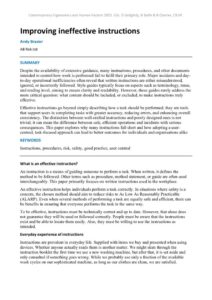| Document | Author Andy Brazier |
| Abstract Despite the availability of extensive guidance, many instructions, procedures, and other documents intended to control how work is performed fail to fulfil their primary role. Major incidents and day-to-day operational inefficiencies often reveal that written instructions are either misunderstood, ignored, or incorrectly followed. Style guides typically focus on aspects such as terminology, tense, and reading level, aiming to ensure clarity and readability. However, these guides rarely address the more critical question: what content should be included, or excluded, to make instructions truly effective. Effective instructions go beyond simply describing how a task should be performed; they are tools that support users in completing tasks with greater accuracy, reducing errors, and enhancing overall consistency. The distinction between well-crafted instructions and poorly designed ones is not trivial; it can mean the difference between safe, efficient operations and incidents with serious consequences. This paper explores why many instructions fall short and how adopting a user-centred, task-focused approach can lead to better outcomes for individuals and organisations alike |

